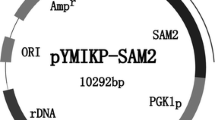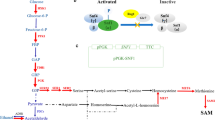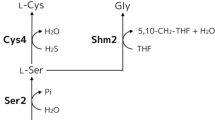Abstract
S-adenosyl-l-methionine (SAM), biosynthesized from methionine and ATP, exhibited diverse pharmaceutical applications. To enhance SAM accumulation in S. cerevisiae CGMCC 2842 (wild type), improvement of methionine and ATP availability through MET6 and SAM2 co-expression combined with sodium citrate feeding was investigated here. Feeding 6 g/L methionine at 12 h into medium was found to increase SAM accumulation by 38 % in wild type strain. Based on this result, MET6, encoding methionine synthase, was overexpressed, which caused a 59 % increase of SAM. To redirect intracellular methionine into SAM, MET6 and SAM2 (encoding methionine adenosyltransferase) were co-expressed to obtain the recombinant strain YGSPM in which the SAM accumulation was 2.34-fold of wild type strain. The data obtained showed that co-expression of MET6 and SAM2 improved intracellular methionine availability and redirected the methionine to SAM biosynthesis. To elevate intracellular ATP levels, 6 g/L sodium citrate, used as an auxiliary energy substrate, was fed into the batch fermentation medium, and an additional 19 % increase of SAM was observed after sodium citrate addition. Meanwhile, it was found that addition of sodium citrate improved the isocitrate dehydrogenase activity which was associated with the intracellular ATP levels. The results demonstrated that addition of sodium citrate improved intracellular ATP levels which promoted conversion of methionine into SAM. This study presented a feasible approach with considerable potential for developing highly SAM-productive strains based on improving methionine and ATP availability.




Similar content being viewed by others
References
Amberg CD, Burker DJ, Strathern JN (2005) Methods in yeast genetics. Cold Spring Harbor Press, Cold Spring Harbor
Bradley JD, Flusser D, Katz BP, Schumacher HR Jr, Brandt KD, Chambers MA, Zonay LJ (1994) A randomized, double blind, placebo controlled trial of intravenous loading with S-adenosylmethionine (SAM) followed by oral SAM therapy in patients with knee osteoarthritis. J Rheumatol 21:905–911
Cao X, Yang M, Xia Y, Dou J, Chen K, Wang H, Xi T, Zhou C (2012) Strain improvement for enhanced production of S-adenosyl-l-methionine in Saccharomyces cerevisiae based on ethionine-resistance and SAM synthetase activity. Ann Microbiol 62:1395–1402
Cederbaum AI (2010) Hepatoprotective effects of S-adenosyl-l-methionine against alcohol- and cytochrome P450 2EI-induced injury. World J Gastroenterol 16:1366–1376
Chen S, Chu J, Zhuang Y, Zhang S (2005) Enhancement of inosine production by Bacillus subtilis through suppression of carbon overflow by sodium citrate. Biotechnol Lett 27:689–692
Chen Y, Li SY, Xiong J, Li ZJ, Bai JX, Zhang L, Ye Q, Ouyang PK, Ying HJ (2010) The mechanisms of citrate on regulating the distribution of carbon flux in the biosynthesis of uridine 5′-monophosphate by Saccharomyces cerevisiae. Appl Microbiol Biotechnol 86:75–81
Choi ES, Park BS, Lee SW, Oh MK et al (2009) Increased production of S-adenosyl-l-methionine in recombinant Saccharomyces cerevisiae sake K6. Korean J Chem Eng 26(1):156–159
Drummond JT, Jarrett J et al (1995) Characterization of nonradioactive assays for cobalamin-dependent and cobalamin-independent methionine synthase enzymes. Anal Biochem 228:323–329
Fontecave M, Atta M, Mulliez E (2004) S-adenosyl-l-methionine: nothing goes to waste. Trends Biochem Sci 29:243–249
Gonzalez JC, Banerjee RV, Huang S, Sumner JS, Matthews RG (1992) Comparison of cobalamin-independent and cobalamin-dependent methionine synthases from E. coli: two solutions to the same chemical problem. Biochemistry 31:6045–6056
He J, Deng J, Zheng Y, Gu J (2006) A synergistic effect on the production of S-adenosyl-l-methionine in Pichia pastoris by knocking in of S-adenosyl-l-methionine synthase and knocking out of cystathionine-synthase. J Biotechnol 126:519–527
Huang Y, Gou X, Hu H, Xu Q, Lu Y, Cheng J (2012) Enhanced S-adenosyl-l-methionine production in Saccharomyces cerevisiae by spaceflight culture, overexpressing methionine adenosyltransferase and optimizing cultivation. J Appl Microbiol 112:683–694
Jana AK, Ghosh P (1995) Xanthan biosynthesis in continuous culture: citric acid as an energy source. J Ferment Bioeng 80:485–491
Kant HR, Balamurali M, Meenakshisundaram S (2014) Enhancing precursors availability in Pichia pastoris for the overproduction of S-adenosyl-l-methionine employing molecular strategies with process tuning. J Biotechnol 188:112–121
Liang G, Liao X, Du G, Chen J (2008) Elevated glutathione production by adding precursor amino acids coupled with ATP in high cell density cultivation of Candida utilis. J Appl Microbiol 105:1432–1440
Lieber CS, Packer L (2002) S-Adenosy-l-methionine: molecular, bio-logical, and clinical aspects-an introduction. Am J Clin Nutr 76(Suppl):1148S–1150S
Lin AP, McAlister-Henn L (2002) Isocitrate binding at two functionally distinct sites in yeast NAD+-specific isocitrate dehydrogenase. J Biol Chem 277:22475–22483
Linnebank M, Popp J, Smulders Y, Smith D, Semmler A, Farkas M, Kulic L, Cvetanovska G, Blom H, Stoffel-Wagner B, Kölsch H, Weller M, Jessen F (2010) S-Adenosylmethionine is decreased in the cerebrospinal fluid of patients with Alzheimer’s disease. Neurodegener Dis 7:373–378
Menant A, Barbey R, Thomas D (2006) Substrate-mediated remodeling of methionine transport by multiple ubiquitin-dependent mechanisms in yeast cells. EMBO J 25:4436–4447
Miller G (1959) Use of 3, 5-dinitrosalicylic acid reagent for determination of reducing sugars. Anal Chem 31:426–428
Mountain HA, Bystrom AS, Korch C (1993) The general amino acid control regulates MET4, which encodes a methionine-pathway-specific transcriptional activator of Saccharomyces cerevisiae. Mol Microbiol 7:215–228
Roje S, Chan SY, Kaplan F, Raymond RK, Horne DW, Appling DR, Hanson AD (2002) Metabolic engineering in yeast demonstrates that S-adenosylmethionine controls flux through methylenetetrahydrofolate reductase reaction in vivo. J Biol Chem 277(6):4056–4061
Sanchez C, Neves AR, Cavalheiro J, dos Santos MM, Garcia-Quintans N, Lopez P, Santos H (2008) Contribution of citrate metabolism to the growth of Lactococcus lactis CRL264 at low pH. Appl Environ Microbiol 74:1136–1144
Shiozaki S, Shimizu S, Yamada H (1984) Unusual intracellular accumulation of S-adenosyl-l-methionine by microorganisms. Agric Biol Chem 48:2293–2300
Shiozaki S, Shimizu S, Yamada H (1986) Production of S-adenosyl-l-methionine by Saccharomyces sake. J Biotechnol 4(6):345–354
Thomas D, Surdin-kejian Y (1991) The synthesis of the two S-adenosyl-l-methionine synthetase is differently regulated in Sacchromyces cerevisiae. Mol Gen Genet 226:224–232
Thomas D, Jacquemin I, Surdin-Kerjan Y (1992) MET4, a leucine zipper protein, and centromere-binding factor 1 are both required for transcriptional activation of sulfur metabolism in Saccharomyces cerevisiae. Mol Cell Biol 12:1719–1727
Wang Y, Wang D, Wei G, Shao N (2012) Enhanced co-production of S-adenosylmethionine and glutathione by an ATP-oriented amino acid addition strategy. Bioresour Technol 107:19–24
Wang Y, Wang D, Wei G, Wang C (2013) Improved co-production of S-adenosylmethionine and glutathione using citrate as an auxiliary energy substrate. Bioresour Technol 131:28–32
Yang Y, Yuan C, Dou J, Han XR, Wang H, Fang HQ, Zhou CL (2014) Recombinant expression of glpK and glpD genes improves the accumulation of shikimic acid in E. coli grown on glycerol. World J Microbiol Biotechnol 30:3263–3272
Zhang CY, Lin X, Song HY, Xiao DG (2015) Effects of MAL61 and MAL62 overexpression on maltose fermentation of baker’s yeast in lean dough. World J Microbiol Biotechnol 31:1241–1249
Zhou J, Liu L, Chen J (2011) Improved ATP supply enhances acid tolerance of Candida glabrata during pyruvic acid production. J Appl Microbiol 110:44–53
Acknowledgments
This study was sponsored by Priority Academic Program Development of Jiangsu Higher Education Institutions (PAPD).
Author information
Authors and Affiliations
Corresponding author
Rights and permissions
About this article
Cite this article
Chen, H., Wang, Z., Wang, Z. et al. Improving methionine and ATP availability by MET6 and SAM2 co-expression combined with sodium citrate feeding enhanced SAM accumulation in Saccharomyces cerevisiae . World J Microbiol Biotechnol 32, 56 (2016). https://doi.org/10.1007/s11274-016-2010-y
Received:
Accepted:
Published:
DOI: https://doi.org/10.1007/s11274-016-2010-y




